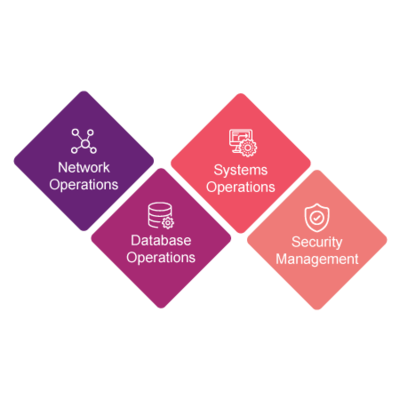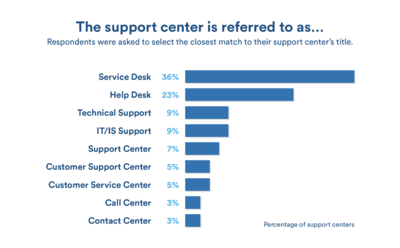Difference between revisions of "IT Service Desk"
| Line 65: | Line 65: | ||
Some would argue that help desk and service desk aren’t that different and, looking into history, the terms were often used interchangeably throughout the 2000s. But the important thing to remember is this: for most, a "service desk" is an evolved version of a help desk created in an ITIL mold. | Some would argue that help desk and service desk aren’t that different and, looking into history, the terms were often used interchangeably throughout the 2000s. But the important thing to remember is this: for most, a "service desk" is an evolved version of a help desk created in an ITIL mold. | ||
| + | |||
| + | |||
| + | == See Also == | ||
| + | <div style="column-count:2;-moz-column-count:3;-webkit-column-count:3"> | ||
| + | [[ITIL (Information Technology Infrastructure Library)]]<br /> | ||
| + | [[ITIL Availability Management]]<br /> | ||
| + | [[ITIL Continual Service Improvement (CSI)]]<br /> | ||
| + | [[ITIL Event Management]]<br /> | ||
| + | [[ITIL Facilities Management]]<br /> | ||
| + | [[ITIL Problem Management]]<br /> | ||
| + | [[ITIL Service Delivery]]<br /> | ||
| + | [[ITIL Service Design]]<br /> | ||
| + | [[ITIL Service Lifecycle]]<br /> | ||
| + | [[ITIL Service Strategy]]<br /> | ||
| + | [[ITIL Service Operation]]<br /> | ||
| + | [[ITIL Service Value Chain (SVC)]]<br /> | ||
| + | [[ITIL Service Value System (SVS)]]<br /> | ||
| + | [[Service Portfolio Management]]<br /> | ||
| + | [[Service Portfolio]]<br /> | ||
| + | [[Service Catalog]]<br /> | ||
| + | [[IT Governance]]<br /> | ||
| + | [[IT Infrastructure]]<br /> | ||
| + | [[IT Operations (Information Technology Operations)]]<br /> | ||
| + | [[COBIT_(Control_Objectives_for_Information_and_Related_Technology)|Control Objectives for Information and Related Technology (COBIT)]]<br /> | ||
| + | [[Balanced Scorecard]]<br /> | ||
| + | [[Enterprise Risk Management (ERM)]]<br /> | ||
| + | [[Risk Management]]<br /> | ||
| + | [[IT_Strategy_(Information_Technology_Strategy)|IT Strategy]]<br /> | ||
| + | [[Business Strategy]]<br /> | ||
| + | [[Corporate Governance]]<br /> | ||
| + | [[Corporate Strategy]]<br /> | ||
| + | [[Enterprise_Architecture|Enterprise Architecture]]<br /> | ||
| + | [[COSO_Internal_Control_Integrated_Framework|COSO Internal Control- Integrated Framework]]<br /> | ||
| + | [[Compliance]]<br /> | ||
| + | </div> | ||
| + | |||
| + | |||
| + | == References == | ||
| + | <references/> | ||
Revision as of 18:55, 24 March 2021
The ITIL definition of the IT Service Desk (service operation) is the single point of contact between the
What is IT Service Desk
service provider and the users. A typical service desk manages incidents and service requests and handles communication with the users. The service desk typically has a help desk component, but its overall goal is to be proactive in improving IT and business processes across the organization. The best service desks are constantly looking for opportunities to run all IT processes, including the help desk, more efficiently. Some key traits of the service desk are:
- Fully integrating with other ITSM processes
- Acting as SPOC for all IT areas, applications, and business processes
- Tracking compliance with service level agreements (SLAs)
- Providing a self-service capability for incident and service requests, with an integrated service catalog
- Integrating and communicating with the configuration management database (CMDB)[1]
Background on IT Service Desk[2]
The IT helpdesk function was born in the late 1980s as a support capability to fix IT issues. It was a highly technical function focused on the technology rather than the end users. Early IT helpdesks didn’t have the concept of SLAs or time-based targets for resolving issues. It wasn’t until ITIL came onto the scene in the 1990s, capturing IT Service Management best practices, that the concept of the user-centric IT service desk began to emerge. The service desk was seen as an essential part of “managing IT like a service”.
In the mid-1990s, research by Iain Middleton of Robert Gordon University found that value was derived not only from a reactive response to user issues, but also from the help desk's unique position of communicating daily with numerous customers or employees. Information gained about technical problems, user preferences, and what satisfies users can be valuable for the planning and development work of IT services.
With the publishing of ITIL v2 in 2001, the Service Desk function and its role in incident and request management became one of the core components of IT service operations in many organizations. As the decade continued, globalization along with increasing pressures to reduce IT operational costs led many organizations to centralize IT Service Desk functions with many engaging 3rd party support partners to staff them. Outsourcing of IT service desk functions led to further standardization of processes and a growth in the market of help desk ticketing software.
Modern technology trends including cloud-services, the widespread use of 3rd party components in the IT ecosystem and advancements in discovery and monitoring capabilities have led to the integration of stand-alone helpdesk ticketing systems into more comprehensive ITSM platforms that serve as the hub of operations not just for the IT service desk, but the entire IT function. As companies seek to further modernize and pursue Digital Transformation initiatives, the IT Service Desk is evolving again to become more business centric, with greater awareness of business processes and data – in many cases becoming an integrated part of companies’ business operations.
Operations Managed by Service Desk in ITIL[3]
- Network Operations: It is the ability to monitor the network connections and devices connected to the network remotely. The service desk has to monitor the changes, incidents, and traffic in the network and ensures that the network infrastructure is optimized for the operations of the organization.
- Systems Operations: It is the ability to manage the core systems of the company. It includes monitoring the performance of the systems, installing software updates, patches and managing changes and support for different platforms used in the company’s systems.
- Database Operations: It is the ability of the service desk to maintain the database by monitoring its performance, reviewing the logs, managing the access and changing control for certain database software such as Oracle.
- Security Management: It is the ability to protect the organization from internal and external security threats. The duty of the service desk is to check for vulnerabilities in the IT infrastructure, monitor the access logs and correlate the data available with the security mandates.
IT Service Desk Features[4]
The multi-purpose role IT service desks fulfill within any organization require a range of applications that expand beyond traditional tech support and management. As such, IT service desk software tends to include the following features:
- Ticket Management: Enables the automatic prioritization, assignment, and monitoring incidents and issues, as raised through different channels, for faster resolution.
- SLA Management: Helps prioritize tickets based on SLAs and determine whether escalation or deadlines should define management rules.
- Task, problem, asset, release, contract, and change management: Organizes tasks and issues to promote collaboration, minimize disruptions, and ensure smooth transitions & product releases, while benefiting from 360-degree visibility of all your IT and business assets
- Knowledge base and customer service portal: Creates a database of relevant information, FAQs and guides that promote self-service and self-help – and drive faster incident resolution. IT users with common queries and issues are directed to the knowledge base as the first course of action.
- Service Catalog: A centralized location that details to different business units the service available. The catalog also provides a form where users can submit a ticket.
- Dashboards: Allows for comprehensive visibility of real-time and past data to help with performance, productivity, effectiveness, and other process optimization.
- Automation: Ensures routine tasks are always performed to completion, freeing up support staff to engage in unique and challenging tasks.
- Analytics: Collects and studies all relevant data to generate actionable insights that can improve service desk performance and results.
Service Desk vs. Help Desk[5]
The service desk was an evolution of the help desk, born out of ITSM best practice framework ITIL (formerly known as the IT Infrastructure Library), and based on the underlying concept of “managing IT as a service.” A help desk was born of IT-centricity (mainframe computing), whereas a service desk was born of IT service-centricity (the above-mentioned ITIL-espoused approach to delivering IT as a service). It might seem petty, but many will say that a help desk provides help, whereas a service desk provides service, i.e. with a service desk there’s a focus on delivering a service to end users with some semblance of customer service. A help desk is considered to be focused on break-fix (what ITIL calls incident management), whereas a service desk is there to assist with not only break-fix but also with service requests (requests for new services) and requests for information (such as “how do I do X?”). Although there’s no reason why a help desk can’t also offer these additional capabilities (other than IT terminology trends). A help desk was an add on to existing IT activities, whereas the service desk is part of a service-based IT service delivery and IT support ecosystem built around something called “the service lifecycle.” Probably a big reason why the term service desk was used over help desk in ITIL. Those versed in ITIL will state that a help desk is tactical, whereas a service desk is strategic. This will, of course, differ across organizations. A help desk might be considered as offering a subset of service desk capabilities by some, or be qualified as limited in scope by statements such as “the evolution of help desk to the service desk.” But of course, one person's help desk is another person's service desk – organizations will call their IT support capability what they want as evidenced by the following HDI research:
We see 41% of help desks and service desks are called something else. Plus, there’s no guarantee that the service desks and help desks reported in this HDI survey align to our descriptions above.
Some would argue that help desk and service desk aren’t that different and, looking into history, the terms were often used interchangeably throughout the 2000s. But the important thing to remember is this: for most, a "service desk" is an evolved version of a help desk created in an ITIL mold.
See Also
ITIL (Information Technology Infrastructure Library)
ITIL Availability Management
ITIL Continual Service Improvement (CSI)
ITIL Event Management
ITIL Facilities Management
ITIL Problem Management
ITIL Service Delivery
ITIL Service Design
ITIL Service Lifecycle
ITIL Service Strategy
ITIL Service Operation
ITIL Service Value Chain (SVC)
ITIL Service Value System (SVS)
Service Portfolio Management
Service Portfolio
Service Catalog
IT Governance
IT Infrastructure
IT Operations (Information Technology Operations)
Control Objectives for Information and Related Technology (COBIT)
Balanced Scorecard
Enterprise Risk Management (ERM)
Risk Management
IT Strategy
Business Strategy
Corporate Governance
Corporate Strategy
Enterprise Architecture
COSO Internal Control- Integrated Framework
Compliance


